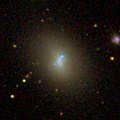Top Qs
Timeline
Chat
Perspective
Local Void
Vast void adjacent to the Local Group From Wikipedia, the free encyclopedia
Remove ads
The Local Void is a vast, empty region of space, lying adjacent to the Local Group.[3][4] Discovered by Brent Tully and Rick Fisher in 1987,[5] the Local Void is now known to be composed of three separate sectors, separated by bridges of "wispy filaments".[4] The precise extent of the void is unknown, but it is at least 45 Mpc (150 million light-years) across,[6] and possibly 150 to 300 Mpc.[7][8] The Local Void appears to have significantly fewer galaxies than expected from standard cosmology.[9]
Remove ads
Remove ads
Location and dimensions
Summarize
Perspective
Voids are affected by the way gravity causes matter in the universe to "clump together", herding galaxies into clusters and chains, which are separated by regions mostly devoid of galaxies, yet the exact mechanisms are subject to scientific debate.[3][10]
Astronomers have previously noticed that the Milky Way sits in a large, flat array of galaxies called the Local Sheet, which bounds the Local Void.[3] The Local Void extends approximately 60 megaparsecs (200 Mly), beginning at the edge of the Local Group.[11] It is believed that the distance from Earth to the centre of the Local Void must be at least 23 megaparsecs (75 Mly).[4]
The size of the Local Void was calculated due to an isolated dwarf galaxy known as ESO 461-36 located inside it. The bigger and emptier the void, the weaker its gravity, and the faster the dwarf should be fleeing the void towards concentrations of matter, yet discrepancies give room for competing theories.[4] Dark energy has been suggested as one alternative explanation for the speedy expulsion of the dwarf galaxy.[3]
An earlier "Hubble Bubble" model, based on measured velocities of Type 1a supernovae, proposed a relative void centred on the Milky Way. Recent analysis of that data, however, suggested that interstellar dust had resulted in misleading measurements.[12]
Several authors have shown that the local universe up to 300 Mpc from the Milky Way is less dense than surrounding areas – by 15–50%. This has been called the Local Void or Local Hole.[7][8] Some media reports have dubbed it the KBC Void,[13] although this name has not been taken up in other publications.[citation needed]
Remove ads
Effect on surroundings
Scientists believe that the Local Void is growing and that the Local Sheet, which makes up one wall of the void, is rushing away from the void's centre at 260 kilometres per second (160 mi/s).[10] Concentrations of matter normally pull together, creating a larger void where matter is rushing away. The Local Void is surrounded uniformly by matter in all directions, except for one sector in which there is nothing, which has the effect of taking more matter away from that sector. The effect on the nearby galaxy is astonishingly large.[4] The Milky Way's velocity away from the Local Void is 970,000 kilometres per hour (600,000 mph).[3][6]
Remove ads
List of void galaxies
Summarize
Perspective
Several void galaxies have been found within the Local Void. These include:
Remove ads
See also
- Dipole repeller – Center of effective repulsion in the large-scale flow of galaxies near the Milky Way
- List of voids
References
Wikiwand - on
Seamless Wikipedia browsing. On steroids.
Remove ads






